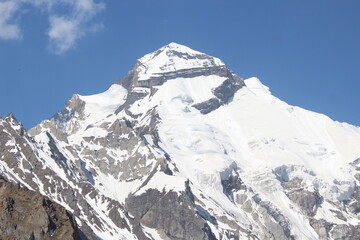
Adi Kailash Yatra Package 2026, often called Chhota Kailash, is one of the most sacred Himalayan pilgrimages located in the Pithoragarh district of Uttarakhand, India. Surrounded by snow-clad peaks, emerald lakes, and tranquil valleys, this divine destination holds immense spiritual significance for Hindus, as it is believed to be the abode of Lord Shiva and Goddess Parvati.
For every traveler or devotee planning the Adi Kailash Yatra, one of the most common questions is: “When to visit Adi Kailash?” Since the region lies close to the Indo-Tibet border at high altitude (around 6,310 meters), the weather plays a crucial role in deciding the best time for this journey.
In this detailed guide, you will learn about the best months to visit Adi Kailash, seasonal weather conditions, and essential travel tips to make your pilgrimage smooth and memorable.
Why Timing Matters for Adi Kailash Yatra?
The Adi Kailash region is situated in the Kumaon Himalayas, where weather changes dramatically with seasons. Harsh winters, heavy monsoon rains, and limited road connectivity make it impossible to access the area throughout the year. Therefore, choosing the right season is very important to enjoy safe travel, comfortable trekking, and mesmerizing views of the divine mountains.
Best Time to Visit Adi Kailash – Month by Month
🌸 Summer Season (May to June) – The Ideal Time
- Temperature: 8°C to 18°C
- Highlights: Clear skies, pleasant weather, snow still visible on mountain peaks, lush green valleys.
- Why Visit: This is considered the best time to visit Adi Kailash. Roads open after winter, trekking becomes easier, and the scenic beauty of Om Parvat, Parvati Sarovar, and surrounding valleys is at its peak. Pilgrims can perform rituals without weather interruptions.
🌧️ Monsoon Season (July to September) – Avoid This Period
- Temperature: 10°C to 20°C
- Highlights: Heavy rainfall, risk of landslides, slippery trekking routes.
- Why Avoid: Though the greenery becomes more vibrant, monsoons in Uttarakhand bring travel disruptions, blocked roads, and potential risks. This is not recommended for pilgrims or trekkers.
🍂 Autumn Season (September to October) – Another Great Option
- Temperature: 5°C to 15°C
- Highlights: Clear skies after monsoon, snow starts returning to peaks, peaceful surroundings.
- Why Visit: This is the second-best time for Adi Kailash Yatra. The weather is stable, visibility is excellent, and the spiritual aura feels even stronger. Many travelers prefer October as it offers both beauty and serenity.
❄️ Winter Season (November to April) – Not Suitable
- Temperature: -5°C to 10°C (drops further in higher areas)
- Highlights: Heavy snowfall, blocked mountain passes, extreme cold.
- Why Avoid: Winters make the region inaccessible. Roads remain closed, and it is not safe for pilgrims. Only the Border Security Forces and locals can sustain in such harsh conditions.
Best Months to Visit Adi Kailash
- Best Months: May, June, September, October
- Avoid: July–August (monsoon) and November–April (winter)
If you want clear weather, smooth trekking, and divine darshan, plan your Adi Kailash Yatra between May–June or September–October.
Travel Tips for Adi Kailash Yatra 2026
- Book in Advance: Adi Kailash Yatra requires inner-line permits as the area is close to the Indo-China border. Always book through an authorized travel operator.
- Carry Warm Clothing: Even in May and June, nights can get extremely cold. Jackets, woolens, gloves, and thermal wear are must-haves.
- Stay Hydrated: At high altitudes, dehydration is common. Carry water bottles and ORS packets.
- Health Checkup: Since the yatra involves altitude of 3,000+ meters, consult your doctor before traveling, especially if you have heart or respiratory issues.
- Essential Gear: Good trekking shoes, raincoat, walking stick, power bank, and torch are essential for the journey.
- Travel Insurance: Opt for insurance that covers high-altitude travel and emergencies.
- Local Guidance: Always follow the instructions of local guides and security forces, as weather in the Himalayas can change suddenly.
Spiritual Significance of Adi Kailash
Adi Kailash is often considered the replica of Mount Kailash in Tibet, making it highly sacred for devotees who cannot travel to Mansarovar. During the yatra, pilgrims also visit:
- Om Parvat – A mountain where the natural snow formation resembles the sacred ‘OM’ symbol.
- Parvati Sarovar (Lake) – A holy lake believed to be where Goddess Parvati used to bathe.
- Gauri Kund – Another sacred waterbody linked with Goddess Parvati.
Visiting during the right season ensures that you can comfortably explore these divine spots without weather-related issues.
Conclusion
So, when to visit Adi Kailash?
The best time to plan your Adi Kailash Yatra is between May–June and September–October. These months offer favorable weather, clear mountain views, and safe trekking conditions. Avoid the monsoon and winter seasons, as the journey becomes difficult and risky.
By planning your pilgrimage at the right time, you can enjoy the divine beauty of the Himalayas, soak in the spiritual vibrations, and create unforgettable memories.
✨ Whether you are seeking spiritual bliss, Himalayan adventure, or peace of mind, the Adi Kailash Yatra is a once-in-a-lifetime journey—best enjoyed when nature is calm and welcoming
When to Visit Adi Kailash – FAQs
1. What is the best time to visit Adi Kailash?
The best time to visit Adi Kailash is from May to October, when the weather is pleasant, roads are open, and the region is accessible.
2. Is Adi Kailash accessible during winter?
No, during November to April, Adi Kailash remains inaccessible due to heavy snowfall and road closures. Yatra is not allowed in these months.
3. Which months are ideal for trekking and darshan?
-
May – June: Best for clear skies and moderate climate.
-
July – August: Monsoon season; landslides and roadblocks are common. Avoid unless necessary.
-
September – October: Best time with post-monsoon greenery, clear views of Adi Kailash, and comfortable weather.
4. What is the temperature at Adi Kailash during Yatra months?
-
May–June: 5°C to 18°C (pleasant days, chilly nights)
-
July–August: 10°C to 20°C (humid with rainfall)
-
September–October: 2°C to 15°C (clear skies, cold nights)
5. When does the official Adi Kailash Yatra start?
The Yatra generally starts in May and continues till October, depending on weather conditions declared by Kumaon Mandal Vikas Nigam (KMVN) and local authorities.
6. Is monsoon a good time to visit Adi Kailash?
No, July and August are not recommended due to heavy rainfall, landslides, and road disruptions. Travel becomes risky during this period.
7. Which is the peak season for Adi Kailash Yatra?
The peak season is September–October, when most pilgrims visit because of clear weather, scenic landscapes, and spiritual significance.
8. Can senior citizens visit Adi Kailash comfortably?
Yes, but the best time for them is May–June and September, when the weather is stable. They should avoid monsoon due to risky road conditions.
9. Do I need special permits to visit Adi Kailash?
Yes, Inner Line Permits are required since Adi Kailash is near the Indo-China border. Permits can be obtained via KMVN or authorized travel operators.
10. What is the difficulty level of visiting Adi Kailash in different months?
-
May–June: Moderate (roads mostly clear)
-
July–August: Challenging (rain, landslides, delays)
-
September–October: Moderate (best time with clear visibility and safe travel)
11. Is it possible to see snow at Adi Kailash?
Yes, snow patches can be seen even in May and early June, and fresh snowfall may occur in late October.
12. How many days are required for Adi Kailash Yatra?
Typically, the Yatra takes 8–10 days depending on the chosen route (Kathgodam, Dharchula, Gunji, Jolingkong).
Visit Now – Mani Mahesh Yatra Package 2026
